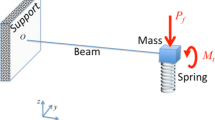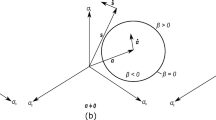Abstract
This paper shows how Benders decomposition can be used for estimating the parameters of a fatigue model. The objective function of such model depends on five parameters of different nature. This makes the parameter estimation problem of the fatigue model suitable for the Benders decomposition, which allows us to use well-behaved and robust parameter estimation methods for the different subproblems. To build the Benders cuts, explicit formulas for the sensitivities (partial derivatives) are obtained. This permits building the classical iterative method, in which upper and lower bounds of the optimal value of the objective function are obtained until convergence. Two alternative objective functions to be optimized are the likelihood and the sum of squares error functions, which relate to the maximum likelihood and the minimum error principles, respectively. The method is illustrated by its application to a real-world problem.
Similar content being viewed by others
Abbreviations
- A :
-
Constant
- M :
-
Constant
- B :
-
Threshold value of log-lifetime
- B 0 :
-
Fixed value of the threshold value of log-lifetime
- C :
-
Endurance limit (logarithm of Δσ)
- C 0 :
-
Fixed value of the endurance limit (logarithm of Δσ)
- E(⋅):
-
Cumulative distribution function
- F(⋅):
-
Cumulative distribution function
- K :
-
Constant
- k :
-
Positive constant used to bound B and C
- ℓ(⋅):
-
Likelihood function
- \({\ell}^{(\nu)}_{\mathrm{up}}\) :
-
Upper bound for ℓ
- \({\ell}^{(\nu)}_{\mathrm{down}}\) :
-
Lower bound for ℓ
- m :
-
Number of pieces at a given level for Δσ
- N :
-
Lifetime or number of cycles
- N ∗ :
-
Dimensionless lifetime
- N i :
-
Lifetime of sample item i
- N 0 :
-
Threshold value for lifetime
- n :
-
Sample size
- P :
-
Probability
- p i :
-
Plotting point value (p i =i/(m+1))
- q(⋅):
-
Functional equation
- \({Q}^{(\nu)}_{\mathrm{up}}\) :
-
Upper bound for Q
- \({Q}^{(\nu)}_{\mathrm{down}}\) :
-
Lower bound for Q
- V i :
-
\(V_{i}=(\log N_{i}-B)(\log\Delta\sigma _{i}-C)=N^{*}_{i}\Delta \sigma^{*}_{i}\)
- z P :
-
Objective function value
- α :
-
Variable used in the Benders decomposition master problem
- β :
-
Weibull shape parameter of the cumulative distribution function in the S−N field
- Δσ :
-
Stress range or amplitude
- Δσ ∗ :
-
Dimensionless stress range or amplitude
- Δσ i :
-
Stress range of sample item i
- Δσ st :
-
Ultimate strength
- Δσ 0 :
-
Threshold value for stress range
- δ :
-
Weibull scale factor
- λ :
-
Parameter defining the position of the corresponding zero-percentile hyperbola
- μ :
-
Mean
- μ :
-
Vector of dual variables associated with inequality constraints
- ν :
-
Counter used for Benders’ cuts
- σ M :
-
Maximum stress
- σ m :
-
Minimum stress
- η :
-
Vector of dual variables associated with equality constraints
References
Aczél, J. (1966). Mathematics in science and engineering: Vol. 19. Lectures on functional equations and their applications. New York: Academic Press.
Aczél, J. (1984). On history, applications and theory of functional equations (introduction). In J. Aczél (Ed.), Functional equations: history, applications and theory (pp. 3–12). Dordrecht: Reidel. Chap. 1.
ASTM (1981). Statistical analysis of fatigue data. American Society for Testing and Materials STP 744, Philadelphia.
Basquin, O. (1910). The exponential law of endurance tests (Technical Report). ASTM, Philadelphia.
Bastenaire, FA (1972). New method for the statistical evaluation of constant stress amplitude fatigue-test results (Technical Report). ASTM, Philadelphia.
Benders, J. F. (1962). Partitioning procedures for solving mixed-variable programming problems. Numerische Mathematik, 4, 238–252.
Bolotin, V. V. (1998). Mechanics of fatigue. Boca Raton: CRC Press.
Buckingham, E. (1915). The principle of similitude. Nature, 96, 396–397.
Cai, X., McKinney, D. C., Lasdon, L. S., & Watkins, D. W. (2001). Solving large nonconvex water resources management models using generalized Benders decomposition. Operations Research, 49, 235–245.
Castillo, E. (1988). Extreme value theory in engineering. San Diego: Academic Press.
Castillo, E., & Fernández-Canteli, A. (2001). A general regression model for lifetime evaluation and prediction. International Journal of Fracture, 107, 117–137.
Castillo, E., & Galambos, J. (1987). Lifetime regression models based on a functional equation of physical nature. Journal of Applied Probability, 24, 160–169.
Castillo, E., & Hadi, A. S. (1994). Parameter and quantile estimation for the generalized extreme-value distribution. Environmetrics, 5, 417–432.
Castillo, E., & Hadi, A. S. (1995). Modeling lifetime data with application to fatigue models. Journal of the American Statistical Association, 90, 1041–1054.
Castillo, E., & Ruiz Cobo, M. R. (1992). Monographs and textbooks in pure and applied mathematics: Vol. 161. Functional equations and modelling in science and engineering. New York: Marcel Dekker.
Castillo, E., Fernández-Canteli, A., Esslinger, V., & Thürlimann (1985). Statistical models for fatigue analysis of wires, strands and cables. In IABSE proceedings, vol. 82 (pp. 1–140).
Castillo, E., Fernández Canteli, A., & Hadi, A. (1999). On fitting a fatigue model to data. International Journal of Fatigue, 21, 97–106.
Castillo, E., Conejo, A., Pedregal, P., García, R., & Alguacil, N. (2001). Building and solving mathematical programming models in engineering and science. New York: Wiley.
Castillo, E., Hadi, A. S., Conejo, A., & Fernández-Canteli, A. (2004). A general method for local sensitivity analysis with application to regression models and other optimization problems. Technometrics, 46(4), 430–445.
Castillo, E., Hadi, A. S., Balakrishnan, N., & Sarabia, J. M. (2005). Extreme value and related models with applications in engineering and science. New York: Wiley.
Castillo, E., Conejo, A. J., Mínguez, R., & Ortigosa, D. (2006a). Perturbation approach to sensitivity analysis in nonlinear programming. Journal of Optimization Theory and Applications, 128(1), 49–74.
Castillo, E., Conejo, A. J., Mínguez, R., & Castillo, C. (2006b). A closed formula for local sensitivity analysis in mathematical programming. Engineering Optimization, 38(1), 93–112.
Castillo, E., Conejo, A. J., Castillo, C., & Mínguez, R. (2007a). Closed formulas in local sensitivity analysis for some classes of linear and non-linear problems. TOP, 15(2), 355–371.
Castillo, E., Fernández-Canteli, A., Hadi, A. S., & López-Aenlle, M. (2007b). A fatigue model with local sensitivity analysis. Fatigue & Fracture of Engineering Materials & Structures, 30(2), 149–168.
Chernick, M. R. (1999). Wiley series in probability and statistics. Bootstrap methods. New York: Wiley.
Choi, J., & Choi, C. (1992). Sensitivity analysis of multilayer perceptron with differentiable activation functions. IEEE Transactions on Neural Networks, 3(1), 101–107.
Coleman, B. D. (1958). On the strength of classical fibres bundles. International Journal of Mechanics of Solids, 7, 60–70.
Coleman, T. F., & Li, Y. (1994). On the convergence of reflective newton methods for large-scale nonlinear minimization subject to bounds. Mathematical Programming, 67(2), 189–224.
Coleman, T. F., & Li, Y. (1996). An interior, trust region approach for nonlinear minimization subject to bounds. SIAM Journal on Optimization, 6, 418–445.
Conejo, A., Castillo, E., Mínguez, R., & García-Bertrand, R. (2006). Decomposition techniques in mathematical programming. Engineering and science applications. Berlin: Springer.
Cordeau, J. F., Soumis, F., & Desrosiers, J. (2000). A benders decomposition approach for the locomotive and car assignment problem. Transportation Science, 34, 133–149.
Cordeau, J. F., Soumis, F., & Desrosiers, J. (2001). Simultaneous assignment of locomotives and cars to passenger trains. Operations Research, 49, 531–548.
Cordeau, J. F., Pasin, F., & Solomon, M. (2006). An integrated model for logistics network design. Annals of Operation Research, 144(24), 59–82.
Costa, A. M. (2005). A survey on Benders decomposition applied to fixed-charge network design problems. Computers & Operations Research, 32, 1429–1450.
Davison, A. C., & Hinkley, D. V. (1997). Cambridge series in statistical and probabilistic mathematics. Bootstrap methods and their applications.
Diaconis, P., & Efron, B. (1983). Computer intensive methods in statistics. Scientific American, 248, 116–130.
Efron, B. (1979). Bootstrap methods: Another look at the jackknife. Annals of Statistics, 7, 1–26.
Efron, B., & Tibshirami, R. J. (1993). Introduction to the bootstrap. London: Chapman and Hall-CRC.
Florian, M., Bushell, G., Ferland, J., Guérin, G., & Nastansky, L. (1976). The engine scheduling problem in a railway network. INFOR, 14(2), 121–138.
Galambos, J. (1987). The asymptotic theory of extreme order statistics, 2nd edn. Malabar: Robert E. Krieger.
Geoffrion, AM (1972). Generalized benders decomposition. Journal of Optimization Theory and Applications, 10(4), 237–260.
Geoffrion, AM, & Graves, G. W. (1974). Multicommodity distribution system-design by benders decomposition. Management Science Series A, Theory, 20(5), 822–844.
Greenwood, JA, Landwehr, J. M., Matalas, N. C., & Wallis, J. R. (1979). Probability weighted moments: Definition and relation to parameters of several distributions expressible in inverse form. Water Resources Research, 15, 1049–1054.
Holmen, JO (1979). Fatigue of concrete by constant and variable amplitude loading. PhD thesis, University of Trondheim.
Hosking, J. R. M., Wallis, J. R., & Wood, E. F. (1985). Estimation of the generalized extreme-value distribution by the method of probability-weighted moments. Technometrics, 27, 251–261.
Jenkinson, A. F. (1969). Statistics of extreme (Technical Report). World Meteorological Office, Geneva.
Kohout, J. (1999). A new function describing fatigue crack growth curves. International Journal of Fatigue, 21, 813–821.
Lawless, J. F. (1982). Statistical models and methods for lifetime data. New York: Wiley.
Mínguez, R., Milano, F., Zárate-Miñano, R., & Conejo, A. J. (2007). Optimal network placement of SVC devices. IEEE Transactions on Power Systems, 22(4), 1851–1860.
Palmgren, A. (1924). Die Lebensdauer von Kugellagern. Verein deutscher Ingenieure, 68(14), 339–3413.
Pascual, F. G., & Meeker, W. Q. (1999). Estimating fatigue curves with the random fatigue-limit model. Technometrics, 41, 89–94.
Prescott, P., & Walden, A. T. (1980). Maximum likelihood estimation of the parameters of the generalized extreme-value distribution. Biometrika, 67, 723–724.
Prescott, P., & Walden, A. T. (1983). Maximum likelihood estimation of the parameters of the generalized extreme-value distribution. Journal of Statistical Computing and Simulation, 16, 241–250.
Saharidis, G. K., & Ierapetritou, M. G. (2009). Resolution method for mixed integer bievel linear problems based on decomposition technique. Journal of Global Optimization, 44, 29–51.
Saharidis, G. K. D., & Ierapetritou, M. G. (2010). Improving benders decomposition using maximum feasible subsystem (MFS) cut generation strategy. Computers & Chemical Engineering, 34(8), 1237–1245.
Saharidis, G. K. D., Michel, M., & Ierapetritou, M. G. (2010). Accelerating benders method using covering cut bundle generation. International Transactions in Operational Research, 17(2), 221–237.
Smith, R. L. (1985). Maximum likelihood estimation in a class of nonregular cases. Biometrika, 72, 67–90.
Spindel, J. E., & Haibach, E. (1981). Some considerations in the statistical determination of the shape of S-N curves (Technical Report). Philadelphia.
Strohmeyer, C. E. (1914). The determination of fatigue limits under alternating stress conditions. Proceedings of the Royal Society of London. Series A, 90(620), 411–425.
Stüssi, F. (1955). Die Theorie der Dauerfestigkeit und die Versuche von August Wöhler. Mitt. TKVSB no. 13.
Weibull, W. (1949). A statistical report of fatigue failure in solids. Transactions no. 27. Stockholm: Royal Institute of Technology of Sweden.
Wöhler, A. (1870). Über die Festigkeits-Versuche mit Eisen und Stahl. Zeitschrift für Bauwesen (20), 73.
Zhao, G. (2001). A log-barrier method with Benders decomposition for solving two-stage stochastic linear programs. Mathematical Programming, 90, 507–536.
Author information
Authors and Affiliations
Corresponding author
Rights and permissions
About this article
Cite this article
Castillo, E., Mínguez, R., Conejo, A.J. et al. Estimating the parameters of a fatigue model using Benders’ decomposition. Ann Oper Res 210, 309–331 (2013). https://doi.org/10.1007/s10479-011-0891-6
Published:
Issue Date:
DOI: https://doi.org/10.1007/s10479-011-0891-6




